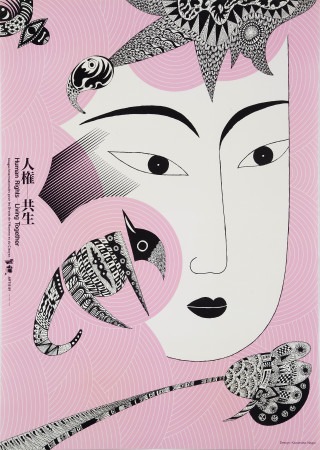Colorful Japan
226 Posters From The Collection
07 Sep 2019 - 02 Feb 2020
COLORFUL JAPAN
226 Posters From The Collection
7 September 2019 - 2 February 2020
The exhibition ‘Colorful Japan’ shows 226 Japanese posters in the Gallery of Honor of the Stedelijk Museum – from floor to ceiling.
Colorful Japan is the Stedelijk Museum’s posthumous tribute to Japanese graphic designer Shigeru Watano (1937-2012) and features 226 Japanese posters on display in the Gallery of Honor. Watano, who lived in the Netherlands, was a vital link between the Stedelijk and numerous Japanese designers. Through his help, the Stedelijk was able to acquire many Japanese posters, and Japanese designers generously donated their work to the museum. In 2018, DNP Foundation for Cultural Promotion presented us with a lavish gift of 92 posters, thanks to which the Stedelijk collection of 800 Japanese posters is leading in Europe.
The exhibition showcases a cross-section of Japan’s unique graphic design with work by designers such as amongst others Hiroshi Ochi, Kazumasa Nagai, Ikko Tanaka, Yusaku Kamekura, Mitsuo Katsui, Shigeo Fukuda, U.G. Sato, Ken Miki and Eiko Ishioka. The oldest poster dates from 1937, the most recent from 2018. One wall of the exhibition is devoted exclusively to the internationally-famed graphic designer and artist Tadanori Yokoo. In 1974, with the help of Watano, the Stedelijk was the first European institute to display his work.
"Spotlighting 226 Japanese posters from our collection, Colorful Japan literally explodes with color. With posters floor-to-ceiling, the Hall of Honor walls immerses visitors in a kaleidoscopic world.
— Curator Carolien Glazenburg
Compared to its European cousin, Japanese poster design is a relatively recent discipline. It wasn’t until the early 20th century that posters became used for advertising.The posters vary widely in style; some flaunt vivid tones, and others are quiet, reserved and minimal. Japanese designers explore a very different visual language to that found in Europe. Japanese visual culture is less direct and morenuanced, very often poetic. Meaning that, to our eyes, the image doesn’t always seem to match the subject, like a magnified character with a lyrical text for a pop concert, for instance.
Japanese characters play an important decorative role when positioned horizontally (European style) and vertically (the traditional Japanese manner). Particularly after World War II, designers use photography to great effect as the medium becomes rapidly accessible and Japanese manufacturers like Canon and Nikon became major players.
226 Posters From The Collection
7 September 2019 - 2 February 2020
The exhibition ‘Colorful Japan’ shows 226 Japanese posters in the Gallery of Honor of the Stedelijk Museum – from floor to ceiling.
Colorful Japan is the Stedelijk Museum’s posthumous tribute to Japanese graphic designer Shigeru Watano (1937-2012) and features 226 Japanese posters on display in the Gallery of Honor. Watano, who lived in the Netherlands, was a vital link between the Stedelijk and numerous Japanese designers. Through his help, the Stedelijk was able to acquire many Japanese posters, and Japanese designers generously donated their work to the museum. In 2018, DNP Foundation for Cultural Promotion presented us with a lavish gift of 92 posters, thanks to which the Stedelijk collection of 800 Japanese posters is leading in Europe.
The exhibition showcases a cross-section of Japan’s unique graphic design with work by designers such as amongst others Hiroshi Ochi, Kazumasa Nagai, Ikko Tanaka, Yusaku Kamekura, Mitsuo Katsui, Shigeo Fukuda, U.G. Sato, Ken Miki and Eiko Ishioka. The oldest poster dates from 1937, the most recent from 2018. One wall of the exhibition is devoted exclusively to the internationally-famed graphic designer and artist Tadanori Yokoo. In 1974, with the help of Watano, the Stedelijk was the first European institute to display his work.
"Spotlighting 226 Japanese posters from our collection, Colorful Japan literally explodes with color. With posters floor-to-ceiling, the Hall of Honor walls immerses visitors in a kaleidoscopic world.
— Curator Carolien Glazenburg
Compared to its European cousin, Japanese poster design is a relatively recent discipline. It wasn’t until the early 20th century that posters became used for advertising.The posters vary widely in style; some flaunt vivid tones, and others are quiet, reserved and minimal. Japanese designers explore a very different visual language to that found in Europe. Japanese visual culture is less direct and morenuanced, very often poetic. Meaning that, to our eyes, the image doesn’t always seem to match the subject, like a magnified character with a lyrical text for a pop concert, for instance.
Japanese characters play an important decorative role when positioned horizontally (European style) and vertically (the traditional Japanese manner). Particularly after World War II, designers use photography to great effect as the medium becomes rapidly accessible and Japanese manufacturers like Canon and Nikon became major players.

